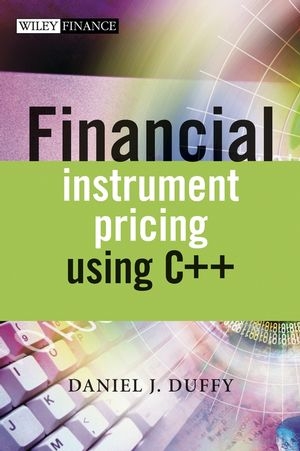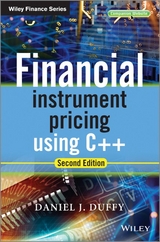
Financial Instrument Pricing Using C++
John Wiley & Sons Inc
978-0-470-85509-6 (ISBN)
- Titel erscheint in neuer Auflage
- Artikel merken
One of the best languages for the development of financial engineering and instrument pricing applications is C++. This book has several features that allow developers to write robust, flexible and extensible software systems. The book is an ANSI/ISO standard, fully object-oriented and interfaces with many third-party applications. It has support for templates and generic programming, massive reusability using templates (?write once?) and support for legacy C applications. In this book, author Daniel J. Duffy brings C++ to the next level by applying it to the design and implementation of classes, libraries and applications for option and derivative pricing models. He employs modern software engineering techniques to produce industrial-strength applications:
Using the Standard Template Library (STL) in finance
Creating your own template classes and functions
Reusable data structures for vectors, matrices and tensors
Classes for numerical analysis (numerical linear algebra ?)
Solving the Black Scholes equations, exact and approximate solutions
Implementing the Finite Difference Method in C++
Integration with the ?Gang of Four? Design Patterns
Interfacing with Excel (output and Add-Ins)
Financial engineering and XML
Cash flow and yield curves
Included with the book is a CD containing the source code in the Datasim Financial Toolkit. You can use this to get up to speed with your C++ applications by reusing existing classes and libraries.
'Unique... Let's all give a warm welcome to modern pricing tools.'
-- Paul Wilmott, mathematician, author and fund manager
Daniel Duffy works for Datasim, an Amsterdam-based trainer and software developer (www.datasim-component.com, www.datasim.nl). He has been working in IT since 1979 and with object-oriented technology since 1987. He received his MSc and PhD theses (in numerical analysis) from Trinity College, Dublin. His current interests are in the modelling of financial instruments using numerical methods (for example, finite difference method) and C++. He can be contacted at dduffy@datasim.nl
1 Executive Overview of this Book 1
1.1 What is this book? 1
1.2 What’s special about this book? 1
1.3 Who is this book for? 2
1.4 Software requirements 3
1.5 The structure of this book 4
1.6 Pedagogical approach 5
1.7 What this book is not 6
1.8 Source code on the CD 6
PART I TEMPLATE PROGRAMMING IN C++
2 A Gentle Introduction to Templates in C++ 9
2.1 Introduction and objectives 9
2.2 Motivation and background 10
2.3 Defining a template 11
2.3.1 An example 13
2.4 Template instantiation 15
2.5 Function templates 16
2.5.1 An example 17
2.6 Default values and typedefs 18
2.7 Guidelines when implementing templates 18
2.8 Conclusions and summary 19
3 An Introduction to the Standard Template Library 20
3.1 Introduction and objectives 20
3.2 A Bird’s-eye view of STL 20
3.3 Sequence containers 23
3.4 Associative containers 27
3.5 Iterators in STL 30
3.6 Algorithms 33
3.7 Using STL for financial instruments 35
3.8 Conclusions and summary 35
4 STL for Financial Engineering Applications 36
4.1 Introduction and objectives 36
4.2 Clever data structures 36
4.3 Set theory and STL 40
4.4 Useful algorithms 43
4.5 STL adaptor containers 45
4.6 Conclusions and summary 46
5 The Property Pattern in Financial Engineering 47
5.1 Introduction and objectives 47
5.2 The Property pattern 47
5.3 An example 51
5.4 Extending the Property pattern: property sets and property lists 52
5.5 Properties and exotic options 57
5.6 Conclusions and summary 59
PART II BUILDING BLOCK CLASSES
6 Arrays, Vectors and Matrices 63
6.1 Introduction and objectives 63
6.2 Motivation and background 64
6.3 A layered approach 66
6.4 The Array and Matrix classes in detail 66
6.5 The Vector and NumericMatrix classes in detail 72
6.6 Associative arrays and matrices 74
6.7 Conclusions and summary 77
7 Arrays and Matrix Properties 78
7.1 Introduction and objectives 78
7.2 An overview of the functionality 78
7.3 Software requirements 79
7.4 The core processes 80
7.5 Other function categories 85
7.6 Using the functions 87
7.7 An introduction to exception handling 88
7.8 Conclusions and summary 90
8 Numerical Linear Algebra 91
8.1 Introduction and objectives 91
8.2 An introduction to numerical linear algebra 91
8.3 Tridiagonal systems 94
8.4 Block tridiagonal systems 99
8.5 What requirements should our matrix satisfy? 101
8.6 Conclusions and summary 102
9 Modelling Functions in C++ 103
9.1 Introduction and objectives 103
9.2 Function pointers in C++ 103
9.3 Function objects in STL 106
9.4 Some function types 109
9.5 Creating your own function classes 111
9.6 Arrays of functions 114
9.7 Vector functions 115
9.8 Real-valued functions 115
9.9 Vector-valued functions 116
9.10 Conclusions and summary 116
10 C++ Classes for Statistical Distributions 117
10.1 Introduction and objectives 117
10.2 Discrete and continuous probability distribution functions 117
10.3 Continuous distributions 119
10.4 Discrete distributions 124
10.5 Tests 127
10.6 Conclusions and summary 128
PART III ORDINARY AND STOCHASTIC DIFFERENTIAL EQUATIONS
11 Numerical Solution of Initial Value Problems: Fundamentals 131
11.1 Introduction and objectives 131
11.2 A model problem 132
11.3 Discretisation 133
11.4 Common schemes 134
11.5 Some theoretical issues 136
11.6 Fitting: Special schemes for difficult problems 137
11.7 Non-linear scalar problems and predictor–corrector methods 138
11.8 Extrapolation techniques 139
11.9 C++ design and implementation 140
11.10 Generalisations 143
11.11 Conclusions and summary 144
12 Stochastic Processes and Stochastic Differential Equations 145
12.1 Introduction and objectives 145
12.2 Random variables and random processes 145
12.3 An introduction to stochastic differential equations 151
12.4 Some finite difference schemes 152
12.5 Which scheme to use? 153
12.6 Systems of SDEs 154
12.7 Conclusions and summary 154
13 Two-Point Boundary Value Problems 155
13.1 Introduction and objectives 155
13.2 Description of problem 155
13.3 (Traditional) centred-difference schemes 157
13.4 Approximation of the boundary conditions 158
13.5 Exponentially fitted schemes and convection–diffusion 160
13.6 Approximating the derivatives 160
13.7 Design issues 161
13.8 Conclusions and summary 163
14 Matrix Iterative Methods 164
14.1 Introduction and objectives 164
14.2 Iterative methods 165
14.3 The Jacobi method 165
14.4 Gauss–Seidel method 166
14.5 Successive overrelaxation (SOR) 166
14.6 Other methods 166
14.7 The linear complementarity problem 168
14.8 Implementation 169
14.9 Conclusions and summary 171
PART IV PROGRAMMING THE BLACK–SCHOLES ENVIRONMENT
15 An Overview of Computational Finance 175
15.1 Introduction and objectives 175
15.2 The development life cycle 175
15.3 Partial differential equations 176
15.4 Numerical approximation of PDEs 177
15.5 The class of finite difference schemes 179
15.6 Special schemes for special problems 179
15.7 Implementation issues and the choice of programming language 180
15.8 Origins and application areas 180
15.9 Conclusions and summary 181
16 Finite Difference Schemes for Black–Scholes 182
16.1 Introduction and objectives 182
16.2 Model problem: The one-dimensional heat equation 182
16.3 The Black–Scholes equation 186
16.4 Initial conditions and exotic options payoffs 187
16.5 Implementation 190
16.6 Method of lines: A whirlwind introduction 190
16.7 Conclusions and summary 191
17 Implicit Finite Difference Schemes for Black–Scholes 192
17.1 Introduction and objectives 192
17.2 Fully implicit method 193
17.3 An introduction to the Crank–Nicolson method 194
17.4 A critique of Crank–Nicolson 195
17.5 Is there hope? the Keller scheme 199
17.6 Conclusions and summary 202
18 Special Schemes for Plain and Exotic Options 203
18.1 Introduction and objectives 203
18.2 Motivating exponentially fitted schemes 203
18.3 Exponentially fitted schemes for parabolic problems 205
18.4 What happens when the volatility goes to zero? 208
18.5 Exponential fitting with explicit time 209
18.6 Exponential fitting and exotic options 210
18.7 Some final remarks 211
19 My First Finite Difference Solver 212
19.1 Introduction and objectives 212
19.2 Modelling partial differential equations in C++ 214
19.3 Finite difference schemes as C++ classes, Part I 218
19.4 Finite difference schemes as C++ classes, Part II 219
19.5 Initialisation issues 220
19.6 Interfacing with Excel 224
19.7 Conclusions and summary 224
20 An Introduction to ADI and Splitting Schemes 225
20.1 Introduction and objectives 225
20.2 A model problem 226
20.3 Motivation and history 227
20.4 Basic ADI scheme for the heat equation 228
20.4.1 Three-dimensional heat equation 229
20.5 Basic splitting scheme for the heat equation 230
20.6 Approximating cross-derivatives 231
20.7 Handling boundary conditions 232
20.8 Algorithms and design issues 234
20.9 Conclusions and summary 236
21 Numerical Approximation of Two-Factor Derivative Models 237
21.1 Introduction and objectives 237
21.2 Two-factor models in financial engineering 237
21.3 Finite difference approximations 241
21.4 ADI schemes for Asian options 242
21.5 Splitting schemes 243
21.6 Conclusions and summary 243
PART V DESIGN PATTERNS
22 A C++ Application for Displaying Numeric Data 247
22.1 Introduction and objectives 247
22.2 Input mechanisms 248
22.3 Conversion and processing mechanisms 249
22.4 Output and display mechanisms 250
22.5 Putting it all together 252
22.6 Output 252
22.7 Other functionality 252
22.8 Using Excel and property sets 258
22.9 Extensions and the road to design patterns 259
22.10 Conclusions and summary 260
23 Object Creational Patterns 261
23.1 Introduction and objectives 261
23.2 The Singleton pattern 263
23.3 The Prototype pattern 270
23.4 Factory Method pattern (virtual constructor) 272
23.5 Abstract Factory pattern 275
23.6 Applications to financial engineering 279
23.7 Conclusions and summary 279
24 Object Structural Patterns 281
24.1 Introduction and objectives 281
24.2 Kinds of structural relationships between classes 281
24.3 Whole–Part pattern 286
24.4 The Composite pattern 288
24.5 The Fa¸cade pattern 289
24.6 The Bridge pattern 290
24.7 Conclusions and summary 295
25 Object Behavioural Patterns 296
25.1 Introduction and objectives 296
25.2 Kinds of behavioural patterns 297
25.3 Iterator pattern 298
25.4 The Visitor pattern 301
25.5 Notification patterns 305
25.6 Conclusions and summary 307
PART VI DESIGN AND DEPLOYMENT ISSUES
26 An Introduction to the Extensible Markup Language 311
26.1 Introduction and objectives 311
26.2 A short history of XML 312
26.3 The XML structure 312
26.4 Document Type Definition 315
26.5 Extensible Stylesheet Language Transformation (XSLT) 320
26.6 An application of XML: Financial products Markup Language 324
26.7 Conclusions and summary 327
27 Advanced XML and Programming Interface 328
27.1 Introduction and objectives 328
27.2 XML Schema 328
27.3 Accessing XML data: The Document Object Model 334
27.4 DOM and C++: The essentials 335
27.5 DOM, entities and property sets 338
27.6 XML structures for plain and barrier options 342
27.7 Conclusions and summary 345
28 Interfacing C++ and Excel 346
28.1 Introduction and objectives 346
28.2 Object model in Excel: An overview 346
28.3 Under the bonnet: Technical details of C++ interfacing to Excel 348
28.4 Implementing the core process 351
28.5 Extensions 354
28.6 Application areas 355
28.7 Conclusions and summary 355
29 Advanced Excel Interfacing 356
29.1 Introduction and objectives 356
29.2 Status report and new requirements 356
29.3 A gentle introduction to Excel add-ins 357
29.4 Automation add-in in detail 359
29.5 Creating a COM add-in 367
29.6 Future trends 373
29.7 Conclusions and summary 373
30 An Extended Application: Option Strategies and Portfolios 374
30.1 Introduction and objectives 374
30.2 Spreads 374
30.3 Combinations: Straddles and strangles 375
30.4 Designing and implementing spreads 376
30.5 Delta hedging 378
30.6 An example 379
30.7 Tips and guidelines 381
Appendices
A1 My C++ refresher 383
A2 Dates and other temporal types 394
References 397
Index 401
| Erscheint lt. Verlag | 30.7.2004 |
|---|---|
| Reihe/Serie | Wiley Finance Series |
| Verlagsort | New York |
| Sprache | englisch |
| Maße | 175 x 252 mm |
| Gewicht | 998 g |
| Themenwelt | Informatik ► Office Programme ► Outlook |
| Mathematik / Informatik ► Informatik ► Software Entwicklung | |
| Wirtschaft ► Betriebswirtschaft / Management ► Finanzierung | |
| ISBN-10 | 0-470-85509-6 / 0470855096 |
| ISBN-13 | 978-0-470-85509-6 / 9780470855096 |
| Zustand | Neuware |
| Informationen gemäß Produktsicherheitsverordnung (GPSR) | |
| Haben Sie eine Frage zum Produkt? |
